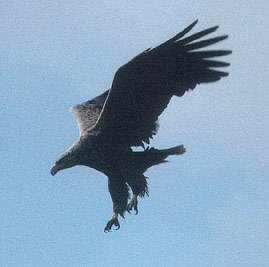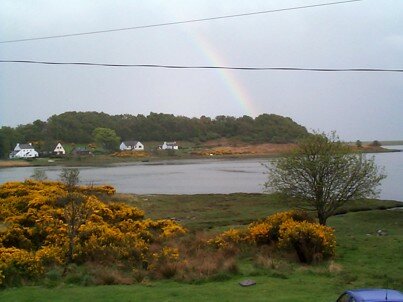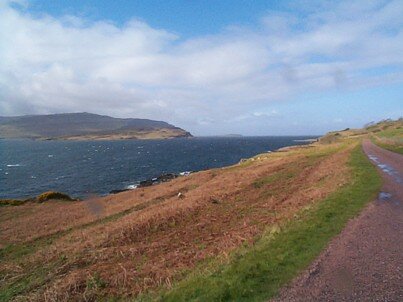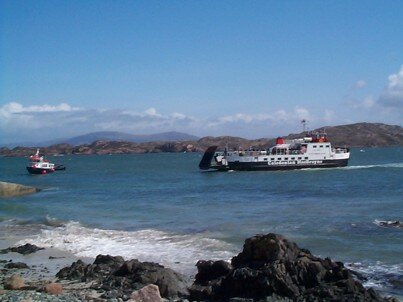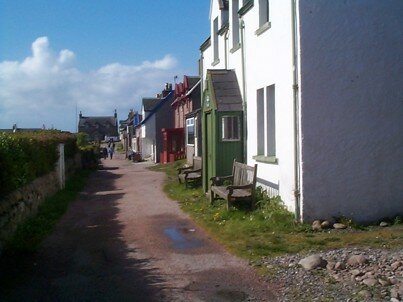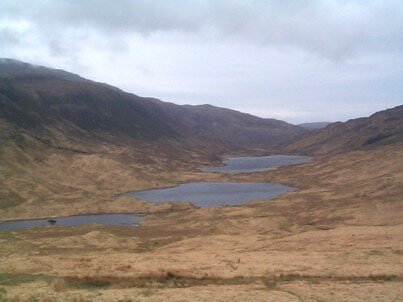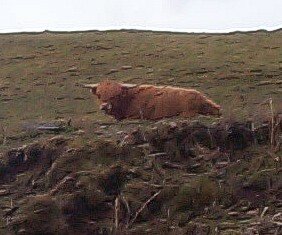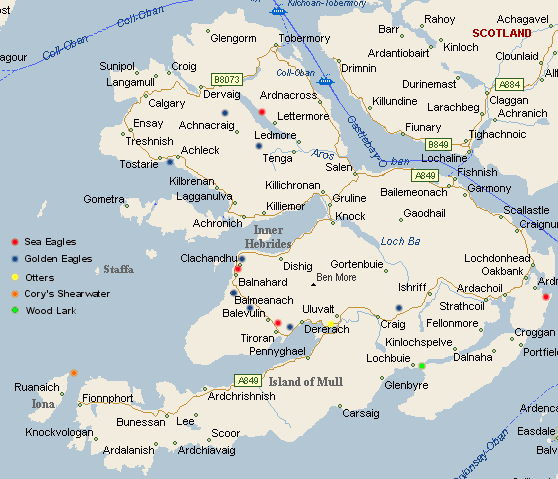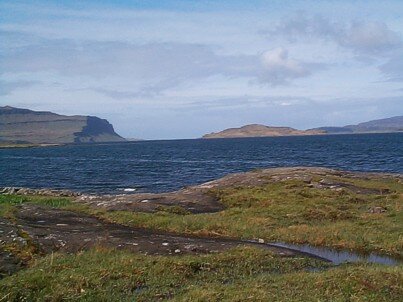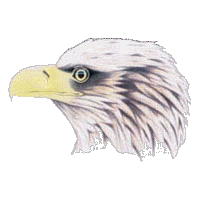By Graham Mee, Web Author. I had been thinking of booking a holiday back in the Highlands and was surfing the web when I came across the Mullbirds website, reading the information on the White-tailed Sea Eagles and Otters caught my imagination and, as I had not seen either of these two species, decided that this was the place to go. The opportunity for Corncrake, another bird on my wish list, finally made up my mind. After thirty minutes on the Internet I had booked for my fianc (Chrissy) and myself our flights, a hire car, the ferry to Mull and our bed and breakfast (it doesn't get any easier than this!). The one thing that struck me as amusing was that the return flights by Easy Jet from Stansted to Glasgow were 6.50 each way for the both of us and the ferry to Mull (40 minutes) was 68.00! Sunday 04th May 2003 We made Oban for the 14:00 ferry sailing and joined the queue of cars sitting in the rain. Suddenly there was an enormous and very loud thump which made us both jump out of our skins and a yellow and white goo spread itself down my windscreen. A local Herring Gull had chosen that precise point to drop a mussel it was carrying and, out of a line of 14 cars, had decided that my hire car would be the best to break it open! Rather shaken I decided to have a little walk round and through the rain had soon picked out two pairs of full summer plumaged Black Guillemot in the harbour. I remember chasing all round Wales to see just two of these birds a few years previously and I really should have come here, over the next week we saw these birds everywhere. On reaching Craignure on the Isle of Mull we headed for our bed and breakfast accommodation at Lochdon. On the short drive it soon became apparent that the island didn't just have a few Wheatear but literally flocks of them. There were also very large numbers of Song Thrush, Willow Warblers, Martins and Swallows. We stayed at Clachan House at Lochdon and about three miles from Grasspoint (see website - click here). This bed and breakfast turned out to be very clean, comfortable and very pleasant indeed. An added bonus that soon became apparent over the next few days was that Clachan House is in an absolutely ideal central position for all the best birdwatching areas. A great breakfast and just out of our bedroom window there were Red Deer and summer plumaged Great Northern Divers, Mergansers and Goosanders on the Loch just in front of us, it doesn't get much better than this. We ended a very tiring first day with 32 species which included a male Hen Harrier at Grasspoint, Cuckoo, Hooded Crows but, as yet, no White-tailed Sea Eagles.
Monday 05th May 2003 The drive, though breathtaking and spectacular as far as scenery goes produced no signs of Sea Eagle but just by Calgary Bay we picked up our first Golden Eagle. After a pleasant stay at the picturesque Tobermory, we called in to the Forestry Commission to enquire after our Sea Eagles. Although we found that we were a week to early for the Sea Eagle watch hide the guys were very helpful and gave us some good pointers for finding our birds. We ended our second day with highlights of Tree Pipit, Rock Pipit, Common Eider, Goosander and Whinchat but still no Sea Eagles! - panic was beginning to set in as I had the impression that they would be easier to find.
Tuesday 06th May 2003 On reaching the shores of Loch na Keal we soon spotted a couple birdwatching and I decided to stop and ask the main birdwatching question that we greet all our fellow enthusiasts with, namely, "What's about?" On leaving the car I had no difficulty whatsoever in placing my foot in a cow-pat the size of a mini roundabout! When the couple and Chrissy had stopped laughing, Chrissy joked that if I was superstitious I would know that I would now have good luck all day - how prophetic this was! After enjoying the views of a Grey Seal colony in the Loch we were driving towards the end of the shore road by the high craigs at Creag Mhr when Chrissy shouted a warning of two birds in the sky. A screech of brakes and the binoculars soon revealed a magnificent pair of calling and displaying Golden Eagles. The female landed on an outcrop of rock and the telescope provided us with the best views of these birds that I have ever had - it was about to get better. The male stayed in the air and constantly dive-bombed and showed off to the female sitting below. All this action soon attracted other birds and we watched as, in turn, the male Golden Eagle was mobbed first by a Peregrine Falcon and then by Ravens. The aerial combat between the Eagle and the Peregrine had to be seen to be believed. While watching the antics above I was also wondering in my mind if I would be able to separate Sea Eagle from Golden Eagle at a distance as I had never seen the former. I had spent some time familiarising myself with all the main identification points between these two birds just in case there might be a doubt - I really needn't have bothered!? I was just thinking that the Peregrine looked like a Cessna attacking a Boeing 737 and marvelling at the relative size difference when through the scope and out from behind the cliffs appeared a Jumbo Jet! We had found our first Sea Eagle and what a truly wonderful, magnificent and stupendous bird this was. Words cannot adequately describe your first sighting of this bird in flight and being able to get the Sea Eagle and the Golden Eagle in the scope at the same time just made you realise just how big the birds are. 'A large body with two house doors at each side' is a description that I have heard and, believe me, it is wholly true. We watched enthralled as the Sea Eagle hit a thermal and soared to an unbelievable height and then disappeared in to the distance over the Loch - all this without a single beat of its huge wings. For about 20 minutes after this, all I could say in a very hushed and humble voice was 'fantastic'. Possibly my greatest and most rewarding birdwatching moment to date. Turning inland we stopped to scan some huge craigs on our right and we soon picked up not one but two more pairs of Golden Eagle, yet another single bird appeared behind us being mobbed by a very small looking bird, coming over our heads the small bird turned out to be a Merlin - yet another indication of the large size of these eagles. We were now looking for our other target species, the wild Sea Otter. I had read various articles which advised that the best way to see these creatures was to stay in the car and not to make any movements. Otters have an extremely keen sense of smell and can detect you from a very long way off. Descending down to the bay at Loch Beg, we spied a car parked and four people standing with binoculars, we pulled up beside them and asked if they had seen any Otters. The reply was "You mean like this one right in front of us?" Not twenty feet away was a lovely male otter lying on the kelp and having a good scratch! The otter was obviously aware of us but just carried on with his scratching while looking at us in what seemed to be a very belligerent way. We set the scope up and and were able to get very, very close views. Very happy indeed, we headed back to Lochdon (after stopping to look at two more Golden Eagles - "No they're not Sea Eagles, They're JUST another pair of Golden Eagles"). When we arrived back at our bed and breakfast Pam, our host, asked if we had seen our Sea Eagle and when I said yes that we had been lucky enough to see one, she then said "have you not seen the pair just down the road then?(!!)". We immediately got back in to the car and headed back down to Grasspoint. No sooner had we got out of the car and set the scope up in the right area we were on to a pair of Sea Eagles sitting in a dead tree. In the hour that we were there the birds stayed in the tree which meant that we were able to drive rather closer and make a quick stop on the road where, through the scope, one of the Eagles bills filled the lens. So ended a truly memorable day.
Wednesday 07th May 2003
Thursday 05th May 2003 Walking up to the Abbey, we were soon surrounded by the rasping calls of Corncrake. Despite spending an hour trying to spot one of these birds and at times hearing them call from no more than a few feet in front of us, we just couldn't get a sighting. Deciding to give up for the time being we headed back to the local bar to get a coffee. On the walk back just before the houses another Corncrake was calling consistently. Looking where the sound appeared to be coming from I focused my binoculars on a small patch of iris. Chrissy walked on a few feet and waited patiently for me. After about five minutes Chrissy called me over but I was determined to see Corncrake and didn't leave my spot or dare take the binoculars from my eyes. Her calls got louder and I admit I was getting a bit tetchy as I didn't want the birds to be frightened. After a few more minutes her voice was getting more persistent and I reluctantly gave up my observation to find out what she wanted. I walked back to her and she then asked "what's that bird sitting on this wall?" Yes, you've guessed it a Corncrake in full view just sitting right out in the open on a stone wall! We then spotted another Corncrake right out in the middle of the field amongst the daisies allowing me to get a full scope view and to let another chap look through my scope at the bird, it turned out that this was his first sighting after trying for five years! The bird flew off to the iris beds shortly afterwards and watching the ungainly flight made us marvel at the fact that these birds manage to migrate from East Africa this far each year. At this point I was beginning to wonder why people have said that these birds are very difficult to see. It would seem that the time to catch these birds is within a week or so of their arrival, in fact, the first bird had been reported on the 27th April. A little later on we were to get very good views of another Corncrake in a rough enclosure by the Nunnery. After all this excitement we decided to take a slow walk up to the northern tip of Iona. Settling down to do some sea watching I soon had diving Gannet, more Black-throated Diver and lots of Common and Black Guillemots. Just as we were about to leave I picked up a Manx Shearwater quite close in, watching this bird another obvious Shearwater flew through the scope even closer. Straight away I knew I hadn't seen this species before but as it turned and glided above the waves I was able to pick out all the main identification features of a Cory's Shearwater. I was able to make out all of the main identification points, the very long bowed wings compared to the Manx, The bright, white underparts, the dark tail, the brownish wing tops with a faint 'w' marking and the slightly darker wing tips. In the good sunlight even the yellow bill and brownish head was noticeable. Leaving Iona we spent a very pleasant evening watching our 'local' Sea Eagles.
Friday 09th May 2003 This last bird was to turn in to perhaps one of my more gratifying finds. As I wasn't sure about records of Woodlark this far north, on my return I spoke to Paul Daw the County Recorder. It would appear that this bird is a very good record for Mull as I was informed that previous years had only produced the odd one or two birds of this species. For the afternoon we we drove back to Loch Scridain for our final look for Eagles. On the way, at Loch Beg we were very pleased to see five more Otters including a female with two cubs. Heading back inland a very hurried stop and a dash for the scope produced some wonderful airborne views of a pair of soaring Sea Eagles and two Golden Eagles (one being mobbed again by a Raven). With one final goodbye to our local Sea Eagle pair (both of which were in the air) we returned for the last time to our bed and breakfast. The Isle of Mull The Isle of Mull is, without any doubt whatsoever, the finest place that we have ever visited for astounding and enthralling views of Eagles. We estimate having seen between 8 to 12 Golden Eagles and possibly 5 Sea Eagles. The scenery is magnificent and breathtaking, the island very peaceful and the local people extremely helpful and at all times very friendly. We both very much look forward to a return visit.
Advice on Visiting Mull
Postscript I have never been superstitious but having stepped in a cow-pat just before seeing my first Sea Eagle and stepping in sheep droppings just prior to seeing my first Corncrake it has made me wonder if this is indeed lucky. Perhaps our readers would like to try this out when next birdwatching and let me know!
?
Grateful thanks are due to: Mrs Pam Appelby of Clachan House bed and breakfast. Thanks for all the lovely meals and for not objecting to my very early birdwatching departures in the mornings. Visit Pam's website at: www.clachanhouse.freeserve.co.uk/ Allan Spellman for the heading picture of the Lochdon Sea Eagle and also for the wonderful and very informative Mullbirds website: www.mullbirds.com
|
Page last updated:
Web Design Graham Mee. ? Copyright of all pages South East Essex RSPB Local Group. All images copyright of owners
The Royal Society for the Protection of Birds. Registered charity no 207076

